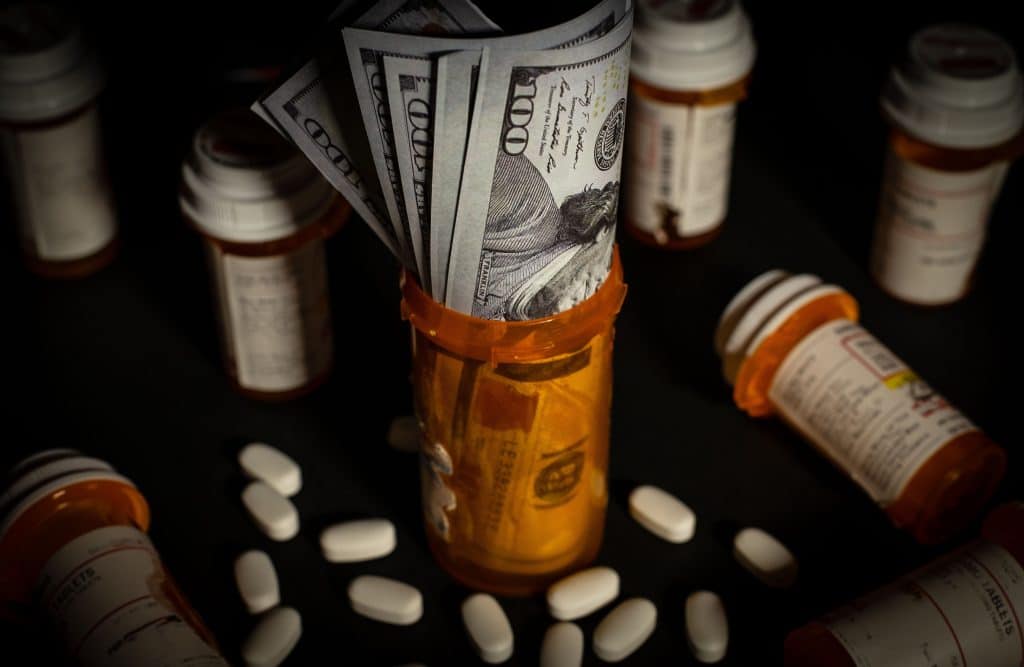Johnson & Johnson and friends are paying out a lot of money for their misdeeds; even if they refuse to admit to doing anything wrong. In fact, every state in the US has at least one opioid lawsuit; with the question now of, where does all that settlement money actually go?
How much must be paid & by who?
There isn’t a finite answer to this question, as not every case against the major players like Johnson & Johnson has been settled. And we’re only talking about America right now anyway. So far, over 3,000 suits have been filed by different states and local governments over the pills which have caused a major death toll in America, Canada, and beyond.
The biggest payout comes in the form of a $26 billion settlement that was made between 46 US states and Johnson & Johnson, AmerisourceBergen, Cardinal Health, and McKesson. It was brokered in 2021, and dubbed the ‘National Settlement.’ This settlement does not include the four states that didn’t sign on, or anything previously decided or still ongoing. The number also doesn’t include separate lawsuits that have been waged against retailers like Walgreens.
Another of the big settlements has to do with the Native American population of America, a population hit very hard by opioids. This lawsuit was also against the four companies involved in the National Settlement, with a total of $590 million to be paid out to federally recognized tribes. It started as a settlement between AmerisourceBergen, Cardinal Health, and McKesson and just the Cherokee tribe for $75 million. This was then increased to $440 million, with a stipulation that it can be accessed by any federally recognized tribe member.
Hi, thanks for being here. Get your direct updates via the Cannadelics Weekly Newsletter; which is also a great source for promos on cannabis buds, vapes & smoking devices, edibles, cannabinoid compounds (like delta-8), amanita mushroom products, and a huge amount more. Let’s all get stoned responsibly!
For its part, Johnson & Johnson was also included and has two years to pay out $150 million in this particular case. Of that, $18 million is specifically for the Cherokees. To give an idea of the brazen ego of these companies; upon making this settlement, Johnson & Johnson said in a statement that “This settlement is not an admission of any liability or wrongdoing and the company will continue to defend against any litigation that the final agreement does not resolve.” I guess the company just likes paying out big sums of money.
Even more opioid lawsuits
It’ not just the pharma companies and distributors that are set to pay a lot of money. Even retailers got hit with lawsuits. CVS, Walgreens, and Walmart were staring down over 300 lawsuits over opioids, and settled for $13 billion in late 2022.
And what of Purdue specifically? The company that skyrocketed this whole issue with the creation of Oxycontin, and all the lies surrounding the usefulness and addictiveness of this drug? It also is in the process of dealing with the fallout of its blatant disregard for humanity. This company isn’t a corporation, and is privately owned by the Sackler family. The family was made to pay out $6 billion in a 2022 settlement, which goes mostly to local and state governments. And this as a part of a revised bankruptcy settlement, just to give an idea how much these little pills are hurting everyone…including those who made them.

Even the federal government, which allows the opioids through regulation, is a part of it. The US Justice department made an $8 billion settlement with Purdue, which was reported in October 2022. And who gets this money? It goes to the Treasury Department, which is allocating $1.775 billion for states, tribes, and local governments for the future. And only $225 million for a “public benefit trust” to state and local communities now. It’s thought that once its all told, approximately $50 billion will be paid out from opioid lawsuits altogether on the state and local level.
Opioid lawsuit money: How is it split?
The whole point of these lawsuits is that the drugs hurt (and are still hurting) a lot of people. Now, sure, you can also say the disability damages affect a wider audience, including governments, but the thing to really remember in this, is who the victims are. And that’s primarily people who started opioids for pain issues. When you think about it, these lawsuits have less to do with people who decided to take up the drugs on their own.
So how does the money get to them? Or does it even? States are bringing in millions and billions of dollars from these opioid lawsuits, so where does the money go? This is where things get a bit complicated. And where we have to hope that the created systems, actually use the money appropriately.
The National Academy for State Health Policy is interested in this question, and compiled data to help elucidate the situation by looking at “state legislation, opioid settlement agreements and spending plans, advisory committees, and other entities charged with disbursing state funding”. According to the agency, all the states are setting up regulated structures for money dissemination; some related to the settlements themselves, and some as a part of new policy.
As the biggest payout as of yet, the National Settlement includes both the ability for states to create their own policies, while also defining some aspects of the payment structure. For example, this settlement includes a timeline for payouts, which stipulates 18 months. The money is split due to factors like overall population; how many overdoes deaths the location had, as well as how many active use cases there are now; and how much of the medications made their way into the location.
What about once a state has the money? The settlement agreement goes on to stipulate a standard rate for dissemination past that point, with 15% of the payment going to a State Fund, 70% to an Abatement Accounts Fund, and the last 15% to a Subdivision Fund. Should a state want to change this policy, it can challenge it. While all this applies to the biggest lawsuit, many settlements have similar instructions.

The ’State Fund’ is money which is “awarded directly to the state, with final spending authority residing with legislative appropriation, attorneys general, the Department of Health, or the state agencies responsible for substance use services.” The Subdivision Fund (Local Share) is money paid “directly to participating political subdivisions, including participating cities and counties.” And the Abatement Fund is to “distribute funding across the state.”
Essentially, each state is tasked with coming up with “unique process and administrative structures for allocating funding across state and local entities, identifying abatement needs, obtaining input from the public and experts, providing guidance on priorities and spending activities, and promoting transparency around the use of funds.” And these processes can be used for any opioid lawsuit money from future or already on-going cases.
Opioid lawsuit money, and how it can be used
With the National Settlement as the example, there are some stipulations as to how the money can be used once a state takes it in. This is where we need to make sure that these avenues lead to something useful; and that they don’t get corrupted. Which means watching over the process from beginning to end.
The main point is that at least 70% of this money must be used for ‘opioid remediation efforts,’ which essentially means policies that target the problem and attempt to solve it. As per the wording of the agreement:
“Care, treatment, and other programs and expenditures (including reimbursement for past such programs or expenditures except where this Agreement restricts the use of funds solely to future Opioid Remediation) designed to (1) address the misuse and abuse of opioid products, (2) treat or mitigate opioid use or related disorders, or (3) mitigate other alleged effects of, including on those injured as a result of, the opioid epidemic.” It’s not, however, more specific than this, leaving the individual locations to figure out what these measures should be.
The money must also be used to set up Opioid Settlement Remediation Advisory Committees. These committees are designed to provide some guidance for the remediation process; they only deal with the 70% allocated to the Abatement Accounts Fund.

The problem is that such systems have shown to be corruptible time and time again. To combat this (in some form) there is a guideline set up to try to deter unrelated spending. It stipulates a requirement to report all use of the funding money, including unrelated costs like payments to lawyers, investigation costs, court fees, and administrative fees. However, a requirement to report, doesn’t mean the funds won’t still be used for these purposes. If reported unrelated costs are still covered, the simple action of reporting does not mean the funds won’t be misused. We’ll have to keep an eye out.
Moving forward
Will any of this work, or are we simply filling government coffers, to be blown like so much other government money? The way I see it, there are two ways to look at progress. The first is if those who have been hurt, get repaid for their losses. And the second is in how it works to change the current landscape. Considering most new regulation focuses on decriminalizing drugs and setting up safe use sites, instead of looking at alternatives like ketamine; its certainly hard to see a path for positive change. And realistically, so long as the doctor is the dealer, can we actually expect this problem to go away?
It’s best to remember that no state pursuing an opioid lawsuit has barred the sale of opioids in the state; even with lawsuit money rolling in. Not even one made a guideline for making them harder to get. Kind of a contradiction, and one that shouldn’t be ignored if people really expect that governments are working on their behalf.
Hello readers! Thanks for making your way to Cannadelics.com; an independent news source focusing on the growing cannabis and psychedelics industries. Check us out regularly to stay in-the-loop on important stories, and subscribe to our Cannadelics Weekly Newsletter, to ensure you’re always first to get the news.









